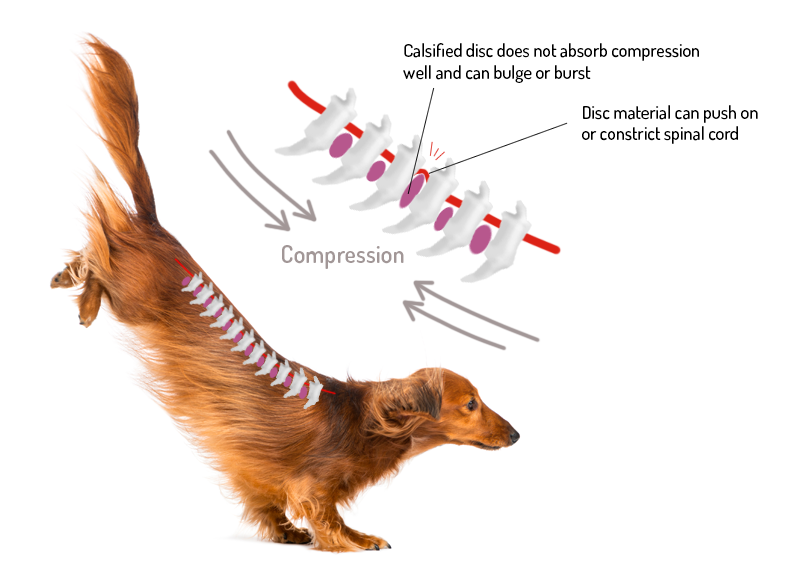What is IVDD?
https://canna-pet.com/intervertebral-disc-disease-ivdd-dogs/
https://canna-pet.com/intervertebral-disc-disease-ivdd-dogs/
Intervertebral disk disease (IVDD) can be described as a slipped disk, ruptured disk, herniated disk, or bulging disk.
What is a disk and its function?
To protect the spinal cord from damage. it runs through a bony canal within the spine and is surrounded by protective bone except the junction of the vertebrae called Inter-vertebral disks. Intervertebral disks are the “cushions” in the space between the spinal vertebrae. The individual vertebrae and inter-vertebral disks allow the back to move up and down, side to side without allowing contact between the bones of the spinal column. IVDD can happen in any of these disks but most commonly happen in the neck (cervical region), the back( thoracolumbar region), or the lower back (lumbosacral region) The type of neurological issues caused will depend on the location on the dogs back where the spinal cord was injured.
Unfortunately, a dog that appears fine one day may take a jump or fall in such away that a disk becomes ruptured. IVDD is a degenerative (gradual) process, but a jump or fall can damage a disk that has already been weakened by IVDD and bring on an acute phase of the disease.
IVDD in dogs causes pressure on the spinal cord. The nerves that come from the spinal cord are what allows the legs and internal organs to function properly. If any of the above described injuries occur, that’s when the spinal cord is compressed and the regular functions are no longer able to function properly.
Consequently, a forceful jump, bad land or fall can cause one or more of these disks to become irritated, displaced, swollen, or rupture. Due to this it causes injury by putting pressure onto the nerves in the spinal cord. This can be very painful, cause nerve damage and possible paralysis.
Alternatively, disk deteriorate (calcify/harden) causing spontaneous degeneration of the outer part of the disk, resulting in bulging possible sudden disk rupture or herniation (slipped disk).Over time the disks in your dogs back lose their flexibility, making them more susceptible to injury. , although the rupture frequently occurs after some sort of traumatic event, such as a fall or even a relatively small jump. This unfortunate compression on the dogs spinal cord can cause extreme back pain, limited mobility, possible paralysis and abnormal nerve conduction.
https://www.celebritydachshund.com/ivdd-info/
Symptoms of IVDD
Cervical (Neck), Thoracic (Chest), Lumbar(Lower Back)
https://www.ivdd.org.au/what-is-ivdd/
Cervical (Neck) disk disease
Grade 1
holding head low
muscle spasms
arching back
shivering, crying, not wanting to move or jump
Grade 2
weakness on all 4 legs
wobbliness: may cross all 4 legs when walking, splayed legs while walking, or walking with all 4 paws knuckled under
Grade 3
an move their legs and wag their tail but lacks the strength to support their own weight and walk
Grade 4
unable to move legs
unable to stand or walk
still has feeling in their back toes
Grade 5
unable to move or feel all 4 legs at all, uncommon but extremely serious
Symptoms of Thoracolumbar (Chest) disk disease
Grade 1
shivering, crying , not wanting to move or jump
muscle spasms
tense belly
Grade 2
weakness in the hind legs
wobbliness: may cross all 4 legs when walking, splayed legs while walking, or walking with all 4 paws knuckled under
Grade 3
can move their legs and wag their tail, but lacks the strength to support their own weight and walk
Grade 4
unable to move their legs
unable to stand or walk
still has feeling in their back toes
Grade 5
unable to move or feel their back legs at all
Symptoms of Lumbosacral (Lower Back) disk disease
pain and difficulty jumping
a limp tail
urinary or fecal incontinence
dilated anus
https://www.thedogsdown.com/how-can-ivdd-cause-paralysis/
How to Diagnose IVDD?
If you fear your dog shown any of the symptoms please get your dog into a veterinarian. Your vet examination will include:
neurological exam
x-rays
myelogram, CT scan, MRI
These tests will locate the source of the spinal injury. Once the location has been found you will than know if its mild to moderate or a more severe case. Treatments will be anything from a steroid and anti-inflammatory with more sever cases surgery maybe advised.
https://www.dachshund-ivdd.uk/symptoms-treatment/clinical-diagnosis/clinical-ivdd-grading-scale/
How to try and prevent IVDD
keep dogs weight down
use a harness to reduce neck stress (www.frenchiestore.com Use FRENCHIEKISS code to receive 10% off your orders)
minimize jumping on and off furniture, stairs ect. use pet steps or a ramp
use a kennel when you can’t be around to supervise your dogs activities
Many neurological conditions can look like IVDD. If you are concerned your dog has symptoms of IVDD or any other spinal cord injury or conditions call your vet today.
Source:
https://www.handicappedpets.com/blog/ivdd-in-dogs/
https://canna-pet.com/intervertebral-disc-disease-ivdd-dogs/
https://www.petmd.com/dog/conditions/neurological/c_dg_intervertebral_disc_disease
https://sevneurology.com/pet-parents/conditions-we-treat/intervertebral-disk-disease/






